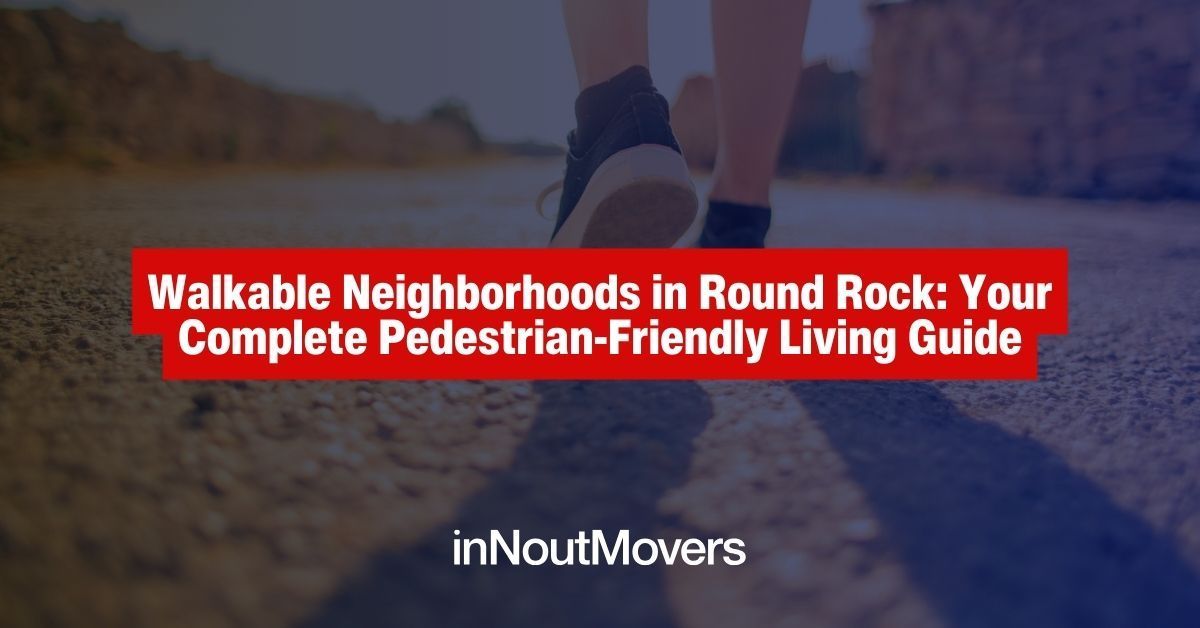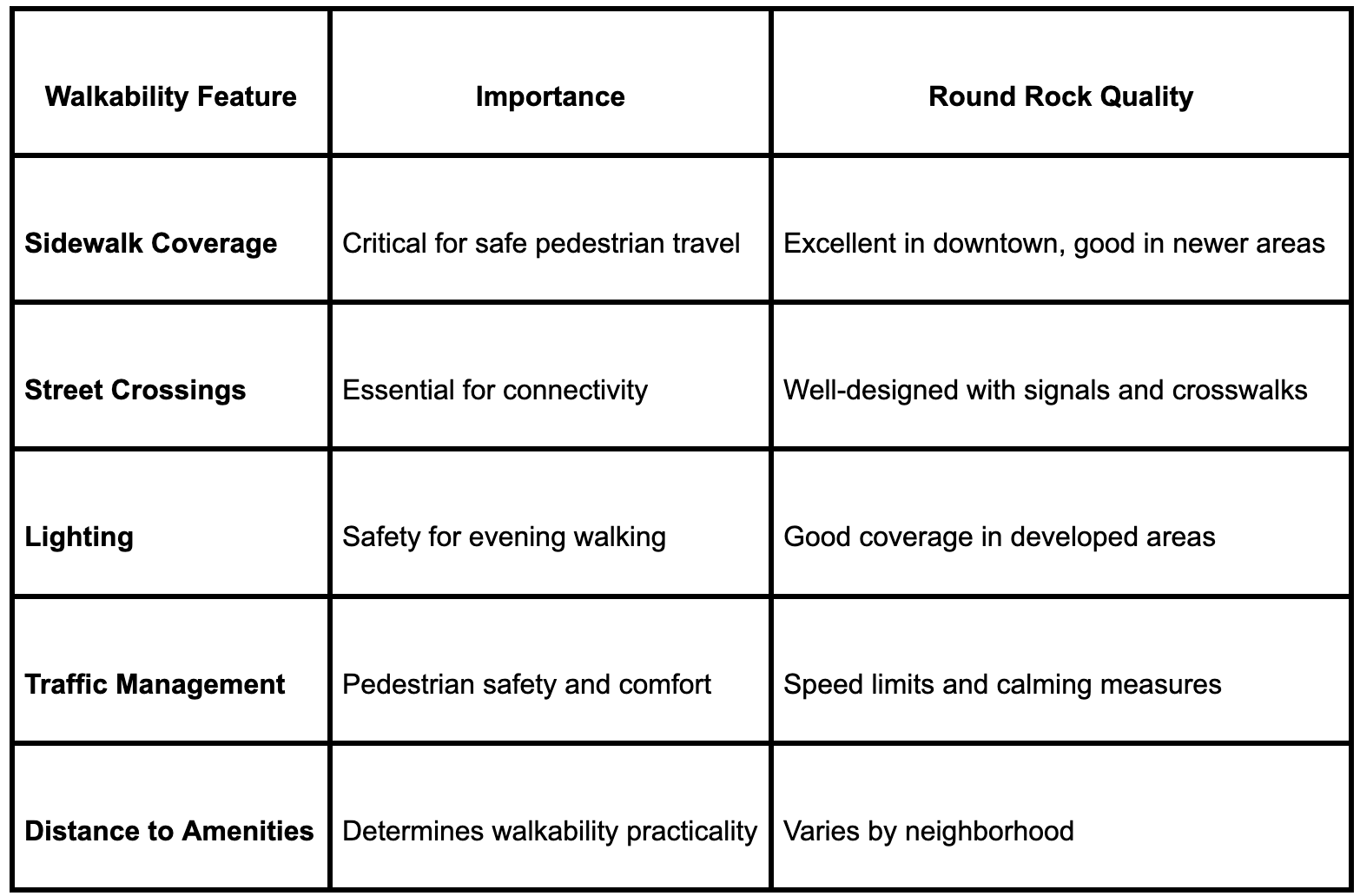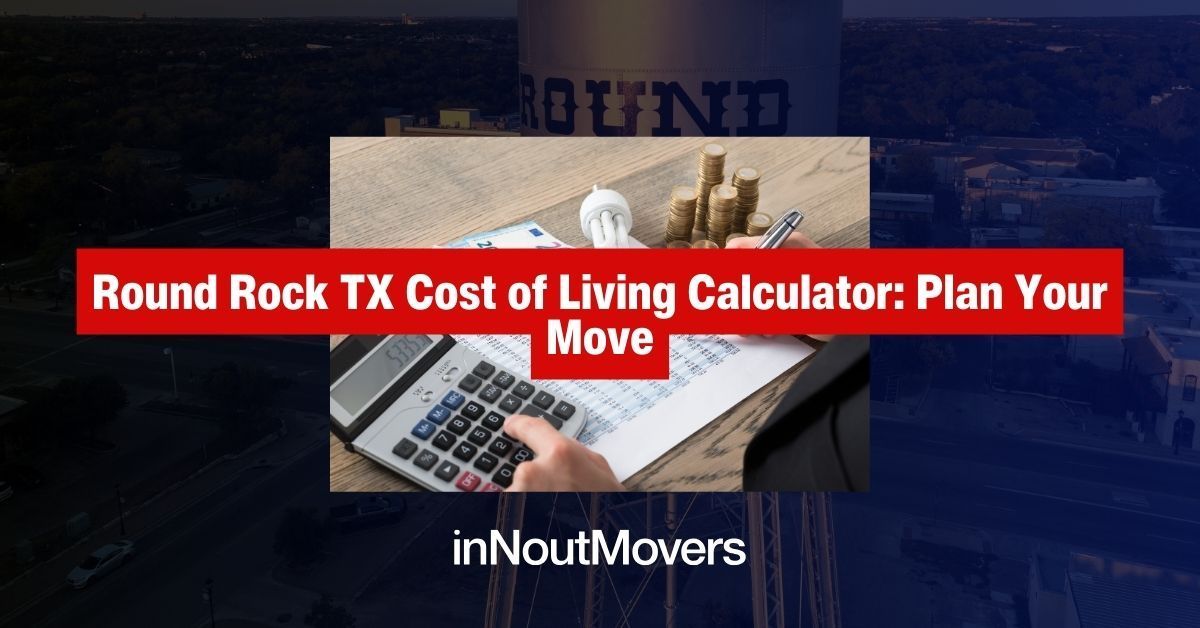Walkable Neighborhoods in Round Rock: Your Complete Pedestrian-Friendly Living Guide
Darion Pug • September 18, 2025

Finding a neighborhood where you can walk to daily amenities, work, and entertainment can transform your quality of life, and we know that planning a move involves balancing convenience with lifestyle goals. If you're researching walkable neighborhoods Round Rock offers, you're exploring one of Central Texas's most thoughtfully planned cities, where strategic development and community design have created several areas that support car-free or car-light living.
Round Rock's commitment to pedestrian-friendly development has resulted in neighborhoods where sidewalks connect to schools, shopping centers, restaurants, and recreational facilities, creating communities that support active lifestyles and reduce dependence on vehicles for daily activities. This comprehensive guide explores the best walkable areas Round Rock provides, analyzing pedestrian infrastructure, nearby amenities, and lifestyle benefits that make these communities ideal for those prioritizing convenience and accessibility.
As relocation specialists who help individuals and families transition throughout Central Texas, InNout Movers understands that walkability considerations increasingly influence neighborhood selection. The areas highlighted in this guide demonstrate how Round Rock neighborhoods with walkability combine convenience with community atmosphere to create exceptional living environments.
Table of Contents
- Understanding Walkability in Round Rock
- Downtown Round Rock: Urban Walkability
- La Frontera District: Modern Pedestrian Design
- University Boulevard Corridor: Connected Living
- Teravista: Master-Planned Walkability
- Round Rock West: Neighborhood Connectivity
- Walkability Features and Infrastructure
- Benefits of Walkable Living
- Choosing Your Walkable Community
Understanding Walkability in Round Rock
Walkable communities Round Rock offers reflect the city's strategic approach to development that prioritizes pedestrian access, mixed-use design, and connectivity between residential areas and essential services. Understanding what makes these neighborhoods walkable helps potential residents identify communities that match their lifestyle preferences.
Walkability Criteria: Truly walkable neighborhoods provide safe, convenient pedestrian access to essential daily needs including grocery stores, restaurants, healthcare facilities, schools, and recreational opportunities within a comfortable walking distance of 0.5 to 1 mile from residential areas.
Infrastructure Requirements: Pedestrian friendly neighborhoods feature comprehensive sidewalk systems, safe street crossings, appropriate lighting for evening walks, traffic calming measures, and connectivity between residential areas and commercial districts.
Mixed-Use Development: The most walkable areas combine residential, commercial, and recreational uses within compact areas, reducing the distance between home and daily destinations while creating vibrant community atmospheres.
Transit Integration: Many walkable neighborhoods also provide access to public transportation, extending walkable access beyond the immediate community to employment centers and regional destinations throughout Central Texas.
Community Design: Successful walkable neighborhoods feature pedestrian-scale development, attractive streetscapes, public gathering spaces, and design elements that make walking pleasant and safe for residents of all ages.
Downtown Round Rock: Urban Walkability
Downtown Round Rock represents the city's most concentrated walkability Round Rock experience, where historic charm meets modern convenience in a compact, pedestrian-friendly environment that supports car-free living for many daily activities.
Pedestrian Infrastructure
Comprehensive Sidewalks: Downtown features complete sidewalk coverage with well-maintained pathways connecting residential areas to business districts, community facilities, and recreational venues. Sidewalks include appropriate width for comfortable pedestrian traffic and accessibility compliance.
Safe Crossings: Strategically placed crosswalks, traffic signals, and pedestrian-activated crossing systems provide safe routes between different downtown districts and ensure pedestrian safety at busy intersections.
Lighting and Safety: Evening lighting throughout downtown pedestrian areas creates safe walking conditions after dark, supporting nighttime activities and extending walkable hours for dining and entertainment.
Daily Amenities Within Walking Distance
Shopping and Services: Downtown provides walkable access to grocery stores, pharmacies, banks, post office, and personal service businesses that handle most daily errands without requiring vehicle transportation.
Dining Options: Diverse restaurant selection ranges from casual coffee shops perfect for morning walks to upscale establishments for evening dining, all accessible via pleasant pedestrian routes through downtown streets.
Healthcare Access: Medical offices, dental practices, and healthcare services located within the downtown area, providing convenient access to routine medical appointments and services.
Entertainment and Recreation
Cultural Venues: Walking access to community theater, art galleries, seasonal festivals, and cultural events creates rich entertainment opportunities within pedestrian-friendly distances.
Parks and Recreation: Downtown parks provide green spaces for relaxation, exercise, and community gatherings, while the library offers resources and programming accessible via short walks from residential areas.
Social Opportunities: Bars, breweries, and entertainment venues create active nightlife scenes that residents can enjoy without driving concerns, supporting social connections and community involvement.
La Frontera District: Modern Pedestrian Design
The La Frontera area exemplifies contemporary Round Rock pedestrian-friendly areas where modern development principles create walkable environments that integrate shopping, dining, employment, and residential options within pedestrian-friendly distances.
Contemporary Design Features
Mixed-Use Development: The district combines residential complexes, office buildings, retail stores, and restaurants within compact, walkable blocks that minimize distances between daily destinations.
Pedestrian Prioritization: Wide sidewalks, pedestrian plazas, and streetscape design that prioritizes walker comfort and safety over vehicle convenience create environments where walking feels natural and pleasant.
Connectivity Planning: Internal trail systems and sidewalk networks connect residential areas to shopping centers, employment locations, and recreational facilities without requiring street-level navigation.
Residential Integration
Apartment Communities: Modern apartment complexes within the district provide immediate walkable access to shopping, dining, and entertainment while maintaining residential tranquility through thoughtful design and landscaping.
Employment Proximity: Office buildings and business centers within walking distance provide employment opportunities for residents who can eliminate commuting entirely by living and working within the same walkable district.
Service Accessibility: Banking, medical services, personal care businesses, and professional services locate within the district, providing convenient access to essential services.
Recreation and Lifestyle
Fitness Options: Multiple gyms, yoga studios, and fitness centers provide walkable access to health and wellness services that support active lifestyles.
Entertainment Venues: Movie theaters, restaurants, bars, and seasonal events create entertainment options that residents can enjoy without vehicle transportation.
Shopping Convenience: Retail stores, specialty shops, and service businesses provide walkable access to shopping needs from everyday essentials to specialty items.
University Boulevard Corridor: Connected Living
The University Boulevard corridor offers neighborhoods near shops and restaurants in Round Rock where strategic development has created pedestrian-friendly environments that connect residential areas with essential services and employment opportunities.
Strategic Location Advantages
Employment Access: Walking or biking distance to major employers including business parks, medical facilities, and government offices provides car-free commuting opportunities for many residents.
Transit Connections: Public transportation access extends walkable reach beyond the immediate neighborhood, providing connections to Austin and other Central Texas employment centers.
Service Clustering: Concentration of essential services including grocery stores, restaurants, medical facilities, and personal services within walkable distances creates convenient daily living.
Residential Options
Diverse Housing: Apartment complexes, townhomes, and single-family homes throughout the corridor provide walkable living options for various budgets and lifestyle preferences.
Proximity Benefits: Residential areas locate within comfortable walking distances of shopping centers, restaurants, and service businesses that handle most daily needs.
Community Connectivity: Sidewalk systems and pedestrian pathways connect different residential areas with each other and with commercial districts.
Walkable Amenities
Daily Services: Banks, post office, pharmacy, grocery stores, and other essential services cluster within walking distance of residential areas.
Dining Variety: Restaurant options from quick casual to sit-down dining provide walkable meal options for breakfast, lunch, and dinner.
Recreation Access: Parks, fitness facilities, and recreational services provide walkable access to health and wellness opportunities.
Teravista: Master-Planned Walkability
Teravista demonstrates how master-planned communities can incorporate moving to walkable neighborhoods Round Rock principles while maintaining suburban character and comprehensive amenities that support pedestrian-friendly living within the community.
Internal Walkability
Trail Systems: Extensive network of walking and biking trails connects different neighborhoods within Teravista, providing safe, pleasant pedestrian routes between residential areas and community amenities.
Community Amenities: Walking access to golf courses, community centers, pools, tennis courts, and recreational facilities allows residents to enjoy community amenities without driving within the community.
Neighborhood Schools: Many residential areas provide safe walking routes to community schools, supporting families who prefer walking school commutes over vehicle transportation.
Community Design
Pedestrian Infrastructure: Comprehensive sidewalk systems, well-maintained pathways, and pedestrian-friendly street design throughout the community support walking for recreation and transportation.
Mixed Amenities: Community centers, recreational facilities, and social venues locate within walking distance of many residential areas, creating opportunities for car-free community participation.
Safety Features: Good lighting, open sight lines, and active community use create safe walking environments throughout different times of day.
Lifestyle Integration
Social Walking: Community design encourages walking for social purposes with neighbors, creating opportunities for community connections and active lifestyles.
Recreational Walking: Trails, parks, and open spaces provide attractive environments for recreational walking, jogging, and outdoor activities.
Daily Activities: Some essential services and amenities within walking distance support car-free living for certain daily activities, though external shopping may require vehicle transportation.
Round Rock West: Neighborhood Connectivity
Western Round Rock areas demonstrate how established neighborhoods can provide car free neighborhoods Round Rock experiences through good connectivity, local services, and pedestrian-friendly infrastructure that supports walkable living.
Established Infrastructure
Sidewalk Coverage: Mature neighborhoods feature comprehensive sidewalk systems that connect residential streets with local schools, parks, and neighborhood commercial areas.
Local Services: Neighborhood shopping centers, schools, and service businesses within walking distance provide access to many daily needs without requiring vehicle transportation.
Park Access: Neighborhood parks, recreational facilities, and green spaces accessible via pedestrian routes provide opportunities for outdoor activities and recreation.
Community Walkability
School Connections: Safe walking routes to neighborhood schools allow families to choose pedestrian school commutes, reducing vehicle dependence and supporting community connections.
Local Business Districts: Small commercial areas within walking distance of residential neighborhoods provide access to restaurants, services, and shopping for daily needs.
Neighbor Networks: Established neighborhoods with pedestrian-friendly design encourage walking for social purposes, creating opportunities for neighbor connections and community involvement.
Infrastructure Benefits
Mature Development: Established infrastructure including sidewalks, lighting, and street design that has evolved to support pedestrian use over time.
Traffic Management: Neighborhood streets with traffic calming measures and pedestrian-friendly design that prioritizes walker safety and comfort.
Connectivity: Links between different neighborhood areas and access to city-wide pedestrian and cycling infrastructure.
Walkability Features and Infrastructure
Understanding the infrastructure elements that create truly pedestrian-friendly neighborhoods helps potential residents evaluate different areas and identify communities that best support their walkable lifestyle goals.
Essential Infrastructure Elements

Public Transportation Integration
Bus Connections: Several walkable neighborhoods provide access to Capital Metro bus routes that extend walkable reach to Austin and regional destinations.
Park and Ride: Facilities that allow residents to walk to transit connections for longer commutes while maintaining car-free daily living.
Future Planning: Regional transportation planning includes expanded public transit that will enhance walkability benefits in connected neighborhoods.
Technology and Innovation
Pedestrian Apps: Technology resources that help residents identify walking routes, distances, and safety information for pedestrian travel throughout Round Rock.
Smart Infrastructure: Traffic signals, crosswalk systems, and lighting that incorporate pedestrian-friendly technology for improved safety and convenience.
Benefits of Walkable Living
Moving to walkable neighborhoods Round Rock provides numerous advantages that extend beyond simple convenience to encompass health, financial, environmental, and social benefits that enhance overall quality of life.
Health and Wellness Benefits
Daily Exercise: Walking for daily activities provides natural exercise integration that supports physical fitness without requiring separate gym time or exercise schedules.
Mental Health: Walking in pleasant neighborhood environments reduces stress, provides fresh air and sunshine, and creates opportunities for mental relaxation and reflection.
Active Lifestyle: Walkable neighborhoods naturally encourage more active lifestyles through pedestrian transportation and recreational walking opportunities.
Financial Advantages
Transportation Savings: Reduced vehicle dependence saves money on gas, parking, vehicle maintenance, and potentially allows families to manage with fewer vehicles.
Healthcare Savings: Increased physical activity from walking lifestyles can contribute to better health and potentially reduced healthcare costs over time.
Convenience Value: Time savings from walking to nearby amenities instead of driving and parking can provide significant convenience value for busy lifestyles.
Environmental Impact
Carbon Reduction: Walking instead of driving for daily activities reduces carbon footprint and environmental impact from vehicle emissions.
Community Sustainability: Walkable neighborhoods support local businesses, reduce infrastructure strain, and contribute to sustainable community development.
Social and Community Benefits
Neighbor Connections: Walking neighborhoods naturally create more opportunities for informal social interactions and community connections with neighbors.
Community Involvement: Easier access to community events, local businesses, and neighborhood activities increases opportunities for civic involvement and local engagement.
For young professionals interested in walkable communities that also offer career amenities and social opportunities, explore our guide to young professional areas in Round Rock which analyzes pedestrian-friendly neighborhoods from a career-focused perspective.
Families considering walkable neighborhoods should review our comprehensive best family neighborhoods in Round Rock guide to understand how pedestrian-friendly communities accommodate family needs including schools, safety, and child-friendly amenities.
To understand how Round Rock's walkable areas fit within the broader context of community amenities, employment opportunities, and quality of life factors, visit our complete Round Rock City Guide: Everything You Need to Know for comprehensive relocation planning information.
Choosing Your Walkable Community
Selecting the right walkable neighborhood requires evaluating your specific needs, lifestyle preferences, and priorities to identify communities that provide the pedestrian-friendly features most important to your daily life.
Lifestyle Assessment
Daily Needs Analysis: Identify which services and amenities you most need within walking distance—work, grocery shopping, healthcare, entertainment, or schools—to prioritize neighborhoods that provide your essential walkable access.
Walking Preferences: Consider whether you prefer urban-style walking with busy streetscapes or suburban walking with trail systems and quieter pedestrian environments.
Transportation Balance: Determine how much of your transportation you want to accomplish on foot versus maintaining vehicle access for longer trips or specific needs.
Practical Considerations
Distance Tolerance: Realistically assess how far you're willing to walk for different types of activities—daily errands, work commutes, entertainment, or exercise.
Weather Factors: Consider Texas weather patterns and how seasonal heat, rain, or cold might affect your walking habits and preferences throughout the year.
Physical Accessibility: Evaluate sidewalk conditions, terrain, and pedestrian infrastructure quality to ensure walkable neighborhoods meet any mobility or accessibility requirements.
Community Integration
Social Opportunities: Look for walkable neighborhoods that provide opportunities to meet neighbors and participate in community activities through pedestrian-friendly design and local gathering spaces.
Safety Comfort: Visit potential neighborhoods at different times of day to assess pedestrian safety, lighting quality, and overall comfort levels for walking.
Future Planning: Consider how walkable neighborhoods might accommodate changing needs as family situations, career requirements, or lifestyle preferences evolve over time.
Conclusion
Round Rock's walkable neighborhoods demonstrate that suburban living doesn't require complete car dependence, with thoughtfully designed communities that support pedestrian lifestyles while maintaining the quality of life advantages that make Central Texas living so appealing. The walkable neighborhoods Round Rock offers range from downtown's urban convenience to master-planned communities' trail systems, each providing unique approaches to pedestrian-friendly living.
Round Rock neighborhoods with walkability prove that convenience and community character can coexist, creating environments where walking becomes a natural part of daily life rather than a special activity. From La Frontera's modern mixed-use design to Teravista's comprehensive trail systems and downtown's historic walkable charm, each area offers distinct advantages for residents prioritizing pedestrian accessibility.
The key to successful walkable living lies in matching neighborhood characteristics with your specific walkability priorities, understanding the infrastructure that supports your pedestrian needs, and choosing communities where walking enhances rather than complicates your daily routines. Round Rock's continued investment in pedestrian infrastructure and mixed-use development ensures that walkable options will continue expanding and improving.
When you're ready to make your move to one of Round Rock's pedestrian-friendly communities,
InNout Movers understands that walkability considerations often influence neighborhood selection and moving logistics. Our efficient, neighborhood-focused approach ensures that your transition to walkable Round Rock living is handled smoothly, allowing you to immediately begin enjoying the convenience and lifestyle benefits of your new pedestrian-friendly community.
InNout Movers: Your Texas Relocation Experts




